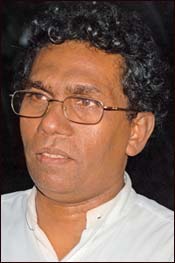Dance as a classical practice
Aravinda Hettiarachchi
“Dance is a technique. It becomes an art on modern stage.” This is a
quote by Ravibandu in a recent discussion on dance theatre. The dance
recital Natahara proved over its 300 novice performers from age three to
35 that the Ravibandu-Samanthi Dance Institution has already brought
this veiled catchphrase authentic in live performance.
You can be an expert thinker in dance by seeking its subject matters
in the course of books or the Internet. Yet whenever a single technique
or concept of this thinking is applied to its own practice, you discover
that this scholarly refinement lacks essence.
|

Ravibandu |
|

Samanthi. Pictures by Sudath Malaweera |
Dance is heartless without the practice of a human body, the main
resource in dance. Can a simple organic corpse create dance in flash on
the stage? No! You have to discipline this body with accurate
techniques.
Ravibandu-Samanthi Dance Institution, through the aptitude they
unclosed in Natahara performance, proved their national mission of
refining hundreds of traditional dancers for the modern theatre. It was
not just an annual ‘school show’ of bubbles and balloons all around to
fascinate the parents by showing them their children performing
‘something’ on modern stage.
It was mostly a concert of performers with basic techniques in
traditional dance, which is looking forwarded in future for a squad of
classical dance in theatre. These youngsters of basic steps are yet to
attain the advance shape of performing art in Dance Theatre.
They still lag behind the full-grown ups of their Institution. Yet
the dancing and playing of percussion instruments of these armatures
confirmed us a positives mark that one day they will climb mountains of
Dance Theatre in a wider-range above their masters.
“Our dancing classes divided basically into four levels of age
limits. But some children who started in very tender ages improved
earlier. We never panic to put them into higher levels. We don’t carry
out a big assemblage for a class. Thus we conduct small groups (lesser
than 20 student each) because it makes the teacher easier to find their
faults.
We, with five teachers, conduct four or five classes in every hour
for four days of a week. Yet each class of small students take over by
two teachers because they need more attention than the grown ups.
Furthermore, we treat these members of tiny age in a different way.
We don’t hurry to thrust them into profound manners. We make them dance
instinctively with some sort of rhythms of the kindergarten, to them to
learn the basic steps without hesitation.
Hence it takes time for them to learn the Classical ways,” uttered
Samanthi the co-head teacher of this institution.
It is precisely a challenge to raise a crowed even of 10 or 20 into
this kind of a refine discipline, which is rooted down to our tropical
and Asiatic ways.
The popular dance culture hoisted up by the electronic media market
has already robbed the attention of the quasi totality of youngsters in
this island.
Therefore, it is already a painstaking duty to reach more than 300
students into a collective of Classical Dance in Theatre.
“We regularly locate the students’ attitudes and behaviors within
classicalness through direct and indirect ways. And we make the
armatures easier into their advance steps by dividing these steps into
attainable tiny pieces.
Yet after they intuitively reached the doorstep of higher levels in
dance, we rationalize them ‘what classical dance is?’ Further, it is not
a full-scale challenge to be a professional in refine dance if you
really get into the authentic flow of learning.
Our sub-cultural environment of dance made even the husbands to allow
their married wives to learn dance. Thus our entire group contains
performers around the age of 30 to 35,” said Samanthi.
The arena of dance in Lanka is huge with a lot of conducts. Yet most
of them reach not lasting excellence in dance.
The Popular trends of cheap amusement coming from Euro-US or India
prejudiced and conquered a massive space of our cultural market.
Thus it is difficult to remain as any classically intended culture in
this island. The popular jovial objectives have multiplied among the
youth in a hurry.
The post 1977 economy has brought Lanka into this level of
entertainment where we should believe ‘everything’ introduced by the
electronic media as art. Thus this vital instant in history should look
out for improved standards in art.
Yet Samanthi’s practice perceive this confusion in a different angle
as, “the parents should be responsible for what their children do.
Parents’ views travel through their children.
If parents desired to see their children in any program on TV, they
hesitate not to engage them in cheap customs.
Yet the parents who wanted to give an extraordinary spiritual
discipline will move their children to the correct path. Some of my
students wanted to go for a popular TV show. So I won’t insist them not
to go.
But we don’t allow them our name to be used in those programs. We
allow them to taste the popular stuff as well within a certain limit
because we know that one day they will come back into their own roots.
Yet if you tight them so much harshly within our ways, they will
easily go stray and will not know where they are loitering.” |



